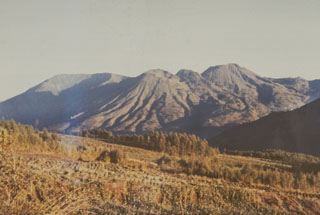Report on Dieng Volcanic Complex (Indonesia) — August 2009
Bulletin of the Global Volcanism Network, vol. 34, no. 8 (August 2009)
Managing Editor: Richard Wunderman.
Dieng Volcanic Complex (Indonesia) Seismicity before a 26 September 2009 phreatic eruption
Please cite this report as:
Global Volcanism Program, 2009. Report on Dieng Volcanic Complex (Indonesia) (Wunderman, R., ed.). Bulletin of the Global Volcanism Network, 34:8. Smithsonian Institution. https://doi.org/10.5479/si.GVP.BGVN200908-263200
Dieng Volcanic Complex
Indonesia
7.2°S, 109.879°E; summit elev. 2565 m
All times are local (unless otherwise noted)
This report describes a phreatic eruption at Dieng on 26 September, an event preceded by increased seismicity. Previously, a phreatic eruption on 15 January 2009 followed the burial and sealing of the floor of the Sibanteng crater by landslides (BGVN 34:04). In the past, a large number of eruptions from the Dieng complex have been minor phreatic events (Germanovich and Lowell, 1995; van Bergen and others, 2000). Monitoring is carried out by the Center for Volcanology and Mitigation of Geologic Disasters (CVGHM) from the village of Karang Tengah.
Seismic activity within the complex began in early September 2009. Four deep volcanic and two shallow volcanic earthquakes preceded a phreatic eruption on 26 September. On that day CVGHM reported a thunderous noise from Dieng heard up to 2 km away. The next day, a phreatic eruption from an unspecified crater ejected mud as far away as 140 m S. The deposits were as thick as 10 cm near the vent and 1 cm near the farthest point of deposition. Scientists did not observe an increase in the concentration of poisonous gases at either the vent or in the surrounding area.
Reference. Germanovich, L.N., and Lowell, R.P., 1995, The mechanism of phreatic eruptions: J. Geophys. Res., v. 100 (B5), p. 8417-8434.
van Bergen, M.J., Bernard, A., Sumarti, S., Sriwana, T., and Sitorus, K., 2000, Crater lakes of Java: Dieng, Kelud and Ijen, Excursion Guidebook, IAVCEI General Assembly, Bali 2000 (URL: www.ulb.ac.be/sciences/cvl/DKIPART1.pdf).
Geological Summary. The Dieng plateau in the highlands of central Java is renowned both for the variety of its volcanic scenery and as a sacred area housing Java's oldest Hindu temples, dating back to the 9th century CE. The Dieng Volcanic Complex consists of multiple stratovolcanoes and more than 20 small Pleistocene-to-Holocene craters and cones over a 6 x 14 km area. Prahu stratovolcano was truncated by a large Pleistocene caldera, which was subsequently filled by a series of cones, lava domes, and craters, many containing lakes. Lava flows cover much of the plateau, but observed activity has been restricted to minor phreatic eruptions. Gas emissions are a hazard at several craters and have caused fatalities. There are abundant thermal features and high heat flow across the area.
Information Contacts: Center of Volcanology and Geological Hazard Mitigation (CVGHM), Jalan Diponegoro 57, Bandung 40122, Indonesia (URL: http://vsi.esdm.go.id/).

